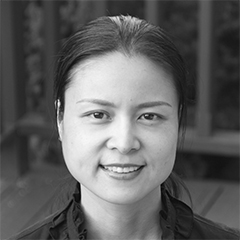September 27, 2017
English professor serves as author, editor of new books about communicating science
Submitted by Communications and Marketing

How to help researchers and writers better communicate scientific research — particularly to the general public — is the focus of two newly released books by an English professor at Kansas State University who specializes in technical writing.
Han Yu, professor of English, is author of "Communicating Genetics: Visualizations and Representations," a monograph published by Palgrave Macmillan on how genetics is visualized for public consumption and understanding — and what's problematic or promising about it. Yu also is lead editor of "Scientific Communication: Practices, Theories, and Pedagogies," an edited collection on the practices, theories and teaching of scientific communication, released by Routledge.
Genetics may seem like an unusual topic for an English professor to explore, but not for Yu.
"I'm fascinated by the topic and believe it is something that will drastically change our lives — if it hasn't already — in the next 50 years," Yu said. "Genetics is not only relevant but essential to the general public. It impacts things as ordinary as what we put on the dinner table, such as genetically modified foods; things as intimate as our reproduction efforts; things such as global as environmental protection and biodiversity; and things as personal as our identity and health."
In "Communicating Genetics: Visualizations and Representations," Yu examines genetic visual representations from four popular science magazines: American Scientist, Popular Science, Science News and Scientific American. Drawing upon public science communication theories, information design theories and social semiotics, the book offers both in-depth analyses and high-level synthesis of how genetics is visualized for the U.S. public from the early 20th century to the present. Individual chapters focus on six visual genres: photographs, micrographs, illustrations, genetic code images, quantitative graphs and molecular structure images.
"Images are far from being simple or straightforward," Yu said. "Based on semiotic theories, or the theory of signs, what you choose to portray in an image, how you portray it, the color you use, the angle you use, how much detail you include, etc., all impact how people understand, feel about and relate to the topic."
Yu wrote her book in response to a common problem she sees with public science communication today.
"We have an obsession with trying to make science communication appear exciting, fascinating, appealing and 'sexy,'" she said. "Certainly, in order to reach nonexpert audiences, we need to make our material engaging. But too often, at least in the realm of visual communication, which is my focus of research in 'Communicating Genetics,' we sacrifice content for format. We are too concerned with using creative or attractive images to attract publics, and we are not worrying as much about whether these images make it easy for publics to understand whatever science it is we are communicating."
For her book, which was four years in the making from planning to publication, Yu did extensive archival research, looking through about 900 articles and more than 5,000 images. The book uses more than 70 of the images, all of which she had to get copyright permissions to use, or re-create or redraw the images herself when the permissions could not be obtained.
Among the reasons Yu wrote the book is because she believes in informed and engaged citizens who can relate to scientists' latest findings in genetics and who can sensibly support but also monitor scientists' work for potential ethical, health and environmental risks. She thinks the book will be particularly useful to scholars of public science communication and visual communication, practitioners of science communication and scientists from a range of related life science disciplines.
"Scientific Communication: Practice, Theory, and Pedagogy," of which Yu served as lead editor, is intended for scholars and teachers of scientific communication. It is well-suited for a graduate-level course on scientific communication.
This book addresses the roles and challenges of people who communicate science, who work with scientists and who teach science, technology, engineering and mathematics, or STEM, majors how to write. Its chapters address themes encountered by scientists and communicators, including ethical challenges, visual displays and communication with publics.
"The pedagogy section covers topics important to instructors' everyday teaching as well as longer-term curricular development," Yu said. "Chapters address delivery of rhetorically informed instruction, communication from experts to the publics, writing assessment, online teaching and communication-intensive pedagogies and curricula."
Yu worked on both books at the same time but said she enjoyed the two different roles each book required.
"Writing a book alone gives me the luxury of obsessing over everything I want to obsess over. I can spend as much time as I think things deserve," she said. "Editing a book gives me the luxury of working with a group of talented people, including my co-editor and chapter authors. I especially like seeing chapters develop in ways I envision and in ways better than I envisioned."
